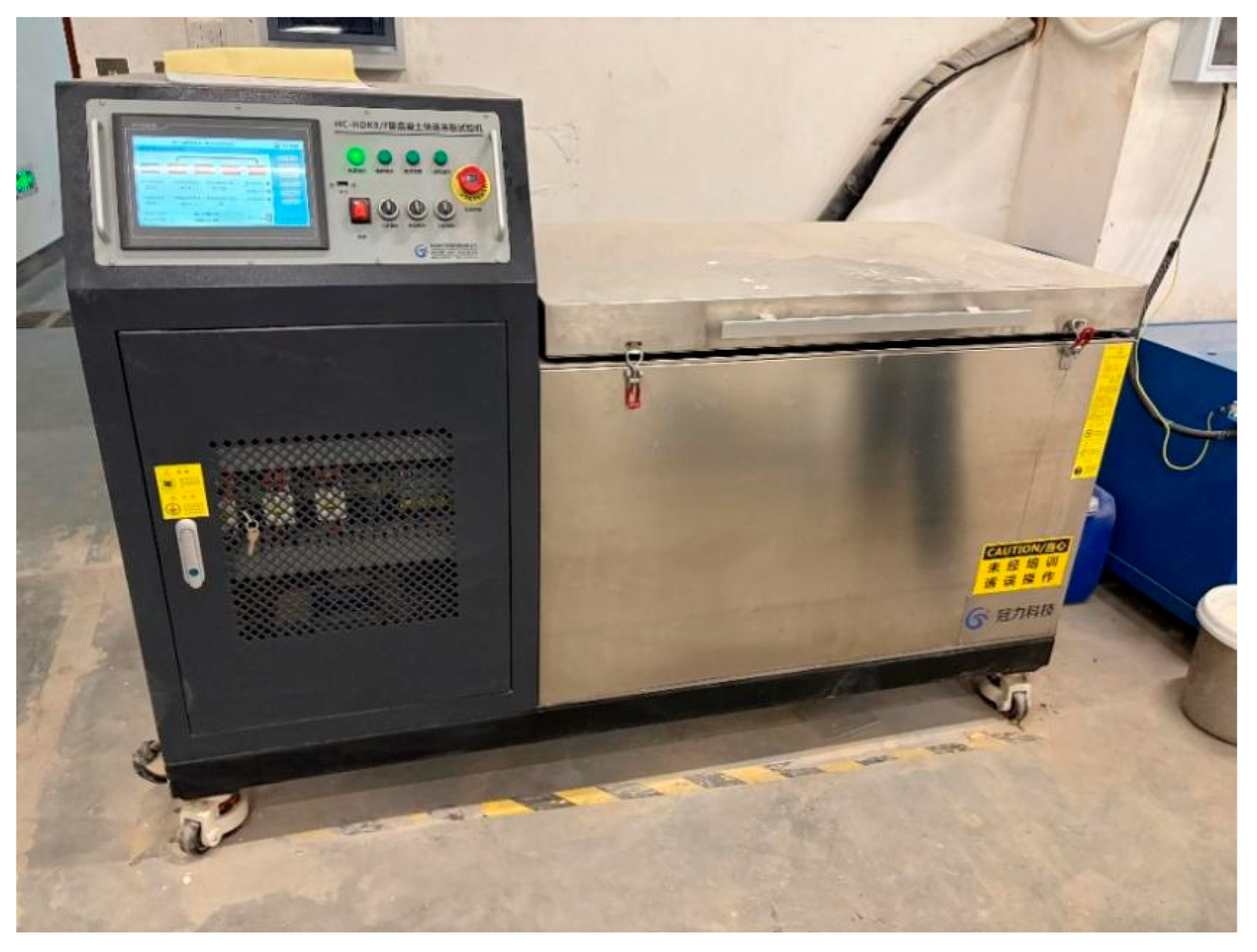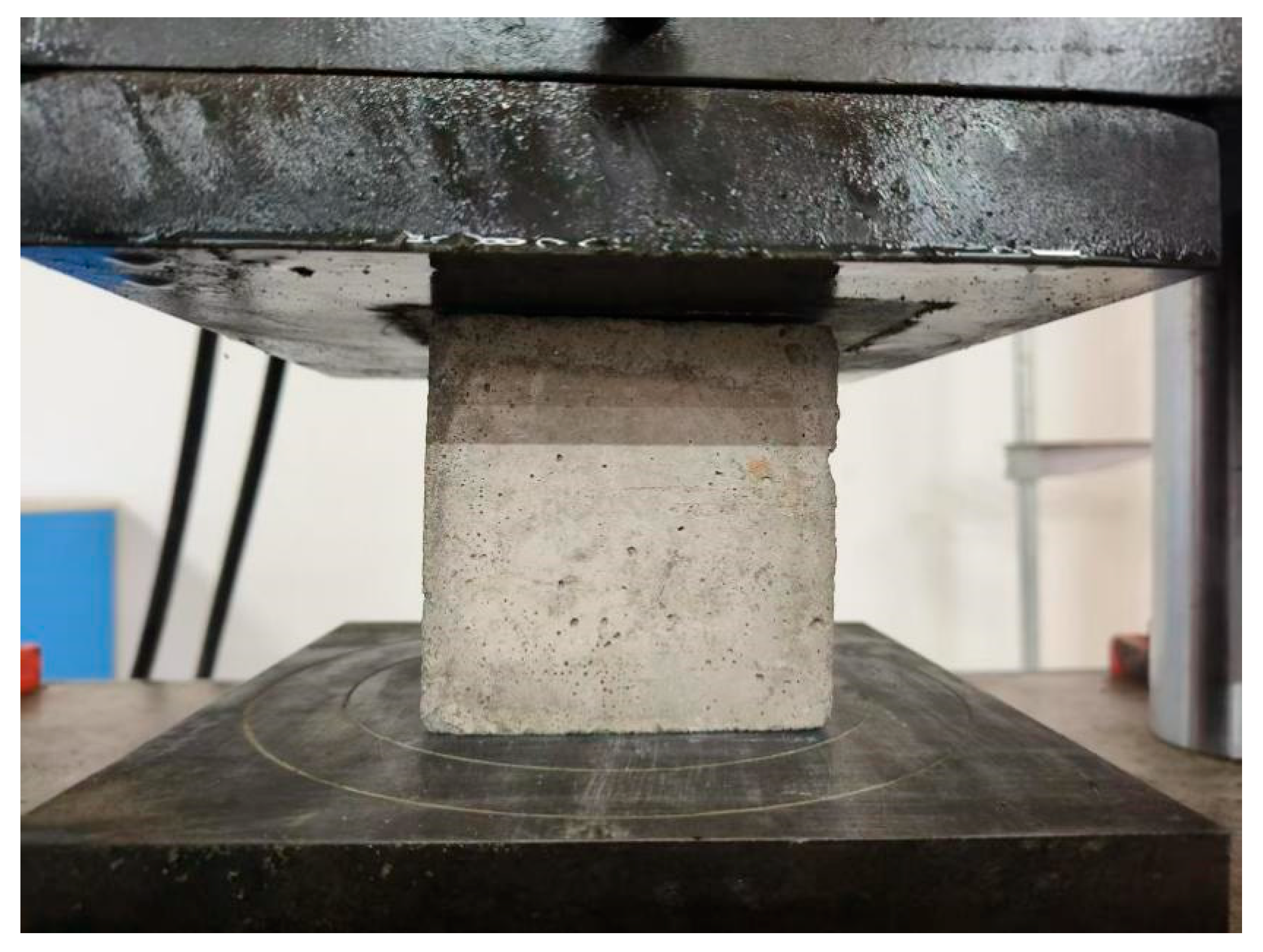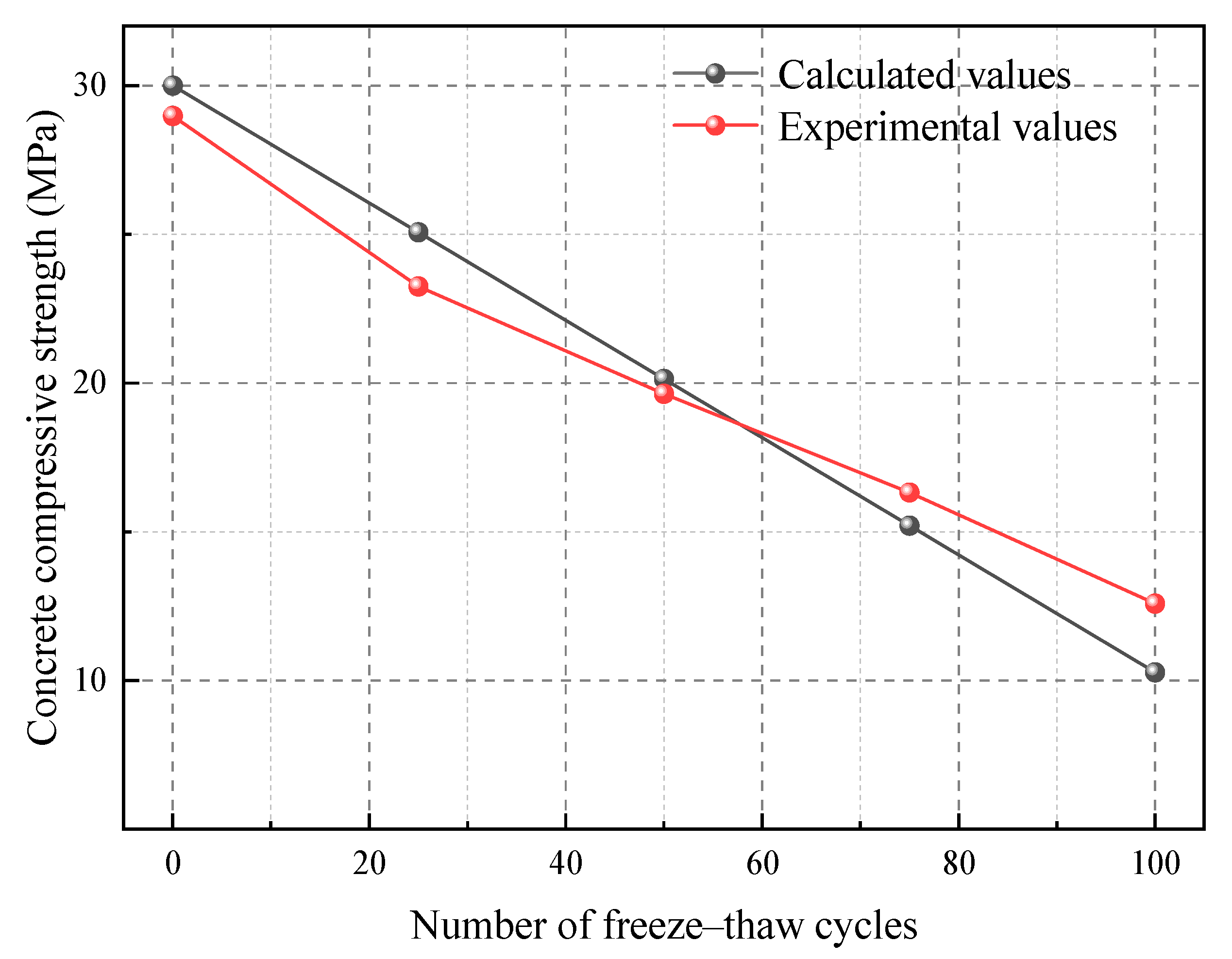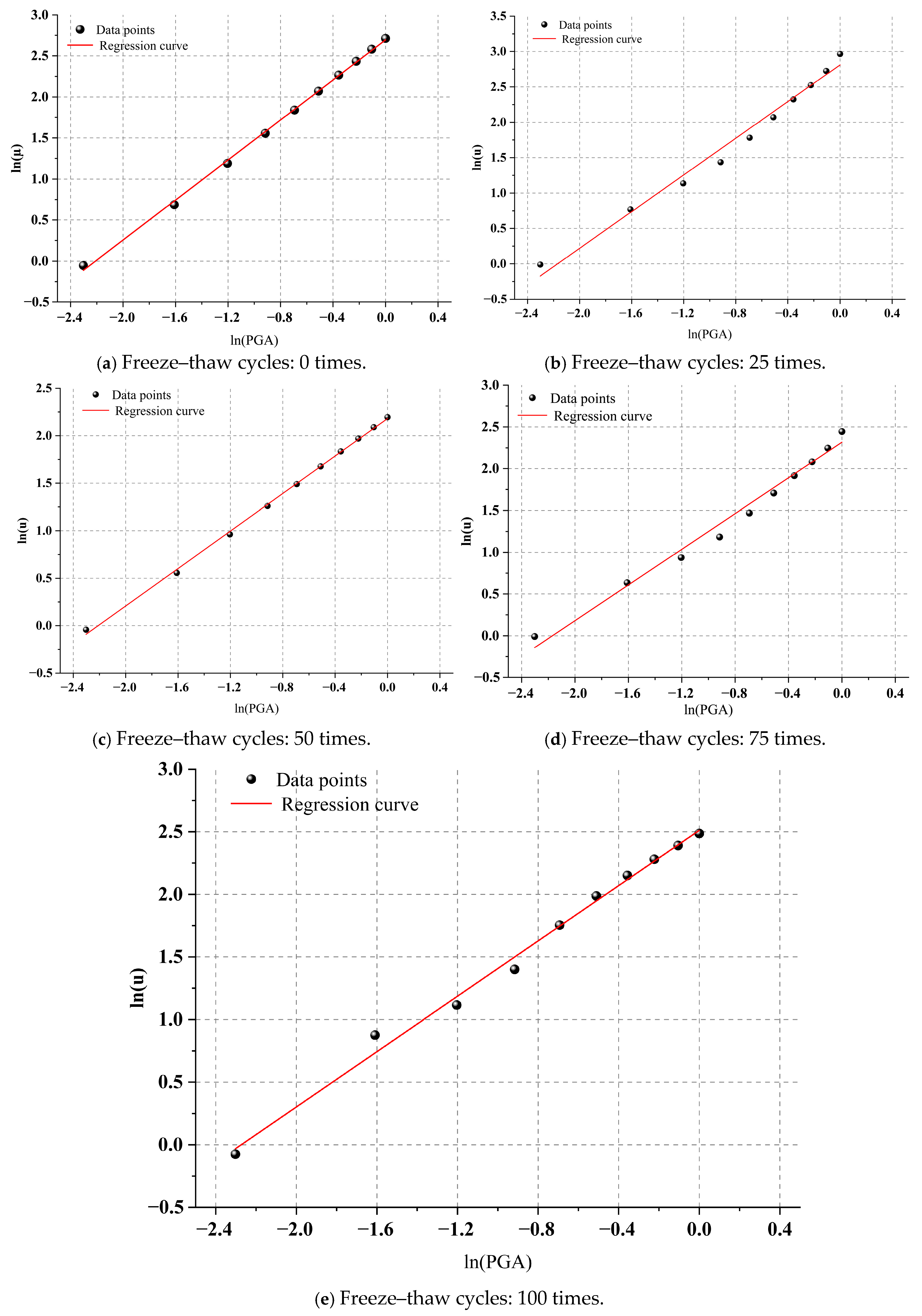Seismic Fragility Analysis of Double-Column Bridge Piers Under Freeze–Thaw Cycles
Abstract
1. Introduction
2. Freeze–Thaw Damaged Pier Model
2.1. Constitutive Models of Concrete and Reinforcement Under Freeze–Thaw Cycles
2.2. Slip Model of Longitudinal Reinforcement Considering Freeze–Thaw Damage
2.3. Constitutive Model Validation
3. Seismic Fragility Analysis Method Based on Incremental Dynamic Analysis (IDA)
3.1. Log-Linear Probabilistic Seismic Demand Model
3.2. Development of Theoretical Seismic Fragility Curves Based on IDA
- Based on local site conditions, a set of appropriate ground motion records is selected. A suitable ground motion intensity measure, typically the peak ground acceleration (PGA), is chosen. Each selected ground motion is scaled using a series of amplitude scaling factors to cover a PGA range from 0.1 g to 1.0 g, with increments of 0.05 g or 0.1 g.
- Reasonable damage states and corresponding damage indices are defined and quantified. A nonlinear finite element dynamic analysis model of the component is then established. Nonlinear time history analyses are performed under the selected ground motions, and structural response data are extracted to construct probabilistic seismic demand models (PSDMs) through regression analysis.
- Based on the regression results, the probability that seismic demand exceeds capacity is calculated for each damage state. Fragility curves are then plotted to represent these exceedance probabilities as a function of seismic intensity.
3.3. Damage Index for Bridge Piers
| Damage State | Displacement Ductility Ratio Threshold | Damage Characteristics |
|---|---|---|
| No Damage | Minor cracks appear | |
| Slight Damage | Minor cracks are widely distributed | |
| Moderate Damage | Concrete cover begins to spall | |
| Severe Damage | Concrete is crushed | |
| Complete Damage | Structural collapse |
3.4. Selection of Ground Motion Records
4. Seismic Vulnerability Analysis of Bridge Piers
4.1. Development of Finite Element Model for Bridge Pier
4.2. Seismic Demand Function of Bridge Piers
4.3. Seismic Fragility of Bridge Piers
5. Conclusions and Outlook
5.1. Conclusions
- (1)
- The increase in the number of freeze–thaw cycles significantly enhances the vulnerability of bridge piers under different seismic intensities, particularly evident in the slight and moderate damage levels. In the lower to moderate PGA range, the effect of freeze–thaw cycles markedly increases the probability of exceeding the thresholds for slight and moderate damage. This indicates that freeze–thaw cycles accelerate the accumulation of initial damage in piers, reducing their load-bearing capacity under moderate to low seismic intensities. This result underscores the importance of considering freeze–thaw effects in the design of bridges in cold regions, especially in seismic design. The acceleration of initial damage accumulation due to freeze–thaw cycles should be given full attention to enhance the seismic performance of piers under moderate to low seismic intensities.
- (2)
- At the severe and complete damage levels, the piers demonstrate strong resistance, reflecting the rationality of structural design in terms of durability and safety margin. Even under extreme conditions with PGA = 1.0 g and 100 freeze–thaw cycles, the probability of complete damage remains around 30%. This suggests that the impact of freeze–thaw degradation on the ultimate state is relatively small, and the overall structure of the pier still has good seismic redundancy and reliability. This indicates that the current bridge design codes can, to some extent, ensure the seismic performance of piers under extreme conditions. However, in cold regions, further refinement of design codes is still needed to better address the impact of freeze–thaw cycles on the seismic performance of piers.
5.2. Outlook
- (1)
- In this study, the displacement ductility ratio was selected as the damage assessment index for transverse non-equal-height twin-column piers in mountainous areas. However, structural damage assessment is a complex process. In future research, it is possible to consider introducing composite parameters, such as curvature, as damage indices to complement the displacement ductility ratio.
- (2)
- The number of seismic records selected in this study is limited. In the future, it is possible to consider introducing more seismic records from different regions, with different magnitudes and different focal mechanisms, to more comprehensively evaluate the response characteristics and vulnerability of piers under various seismic conditions, thereby enhancing the universality and accuracy of the research results.
Author Contributions
Funding
Data Availability Statement
Conflicts of Interest
References
- Tang, H.; Xia, C.; Wang, K.; Jiang, J.; Xia, H. Reliability-based vulnerability analysis of bridge pier subjected to debris flow impact. Struct. Infrastruct. Eng. 2024, 20, 1–12. [Google Scholar] [CrossRef]
- Yu, L.S.; Wang, L.; Du, X.L.; Li, Z.Q.; Li, Y.Q. Influence of Cold-Region Ambient Temperature on the Seismic Vulnerability of Continuous Girder Bridges with Plate Rubber Bearings. J. Earthq. Eng. 2024, 46, 105–114. [Google Scholar] [CrossRef]
- Li, H.Y. Experimental Study on the Performance of Concrete Materials in High-Rise Buildings under Cyclic Freeze-Thaw Conditions. J. Guangdong Polytech. Water Resour. Electr. Eng. 2025, 23, 63–67. [Google Scholar]
- Zhang, X.G.; Li, M.F.; Tian, B.; Li, J.H.; Xiong, B.B. Effect of Sustained Load on Freeze-Thaw Performance and Pore Structure of Panel Concrete. J. China Three Gorges Univ. (Nat. Sci.) 2024, 46, 18–24. [Google Scholar] [CrossRef]
- Hasan, M.; Ueda, T.; Sato, Y. Stress–Strain Relationship of Frost-Damaged Concrete Subjected to Fatigue Loading. J. Mater. Civ. Eng. 2008, 20, 37–45. [Google Scholar] [CrossRef]
- Duan, A. Study on Constitutive Relationship of Freeze–Thaw Damaged Concrete and Numerical Simulation of Freeze–Thaw Process. Master’s Thesis, Tsinghua University, Beijing, China, 2009. [Google Scholar]
- Cao, D.F.; Ge, W.J.; Guo, R.Y.; Shen, Y.F.; Wang, B.Y. Experimental Study on Flexural Behavior of Reinforced Concrete Beams after Freeze–Thaw Cycles. J. Build. Struct. 2014, 35, 137–144. [Google Scholar] [CrossRef]
- Cao, D.F.; Qin, X.C.; Yuan, S.F. Full-Scale Experimental Study on Prestressed Concrete Beams after Freeze–Thaw Damage. China Civ. Eng. J. 2013, 46, 38–44. [Google Scholar] [CrossRef]
- Xu, S.H.; Li, A.B.; Ji, Z.Y.; Wang, Y. Seismic Performance of Reinforced Concrete Columns after Freeze–Thaw Cycles. Constr. Build. Mater. 2016, 102, 861–871. [Google Scholar] [CrossRef]
- Zheng, S.S.; Gan, C.L.; Qin, Q.; Yang, W.; Zheng, F. Experimental Study on Seismic Performance of I-Shaped Short-Limb Shear Walls after Freeze–Thaw Cycles. Eng. Mech. 2016, 33, 94–103. [Google Scholar]
- Zheng, J.; Dong, L.G.; Qin, Q.; Zheng, S.S.; Wang, F. Seismic Performance of Beam–Column Joints in RC Frames under Freeze–Thaw Cycles. J. Build. Struct. 2016, 37, 73–81. [Google Scholar] [CrossRef]
- Zhang, C. Numerical Analysis of Seismic Response of RC Bridge Piers Considering Freeze–Thaw Effect. Master’s Thesis, Xi’an University of Architecture and Technology, Xi’an, China, 2020. [Google Scholar]
- Gong, Y.N.; Zhang, S.W.; Lv, A.A. Performance analysis of reinforced concrete columns after freeze-thaw cycles reinforced with basalt fiber fabric. Concr. World 2021, 76–80. [Google Scholar]
- Liu, Y. Seismic Performance of RC Beam-Column Joints Under Freeze-Thaw and Carbonation. Master’s Thesis, Yantai University, Yantai, China, 2020. [Google Scholar]
- He, Y.; Qin, L.Y.; Yang, J. Seismic performance of reinforced concrete frame structures subjected to freeze-thaw cycles. China Meas. 2021, 47, 101–108. [Google Scholar]
- Du, X.D.; Wu, J.J.; Cao, D.F. Finite element analysis of seismic performance of prestressed concrete continuous beam bridges after freeze-thaw cycles. In Proceedings of the 2008 Jiangsu Mechanics Academic Conference and the 4th Sino-Hong Kong Forum on Mechanics and Its Applications, Suzhou, China, 16–17 May 2008; pp. 330–336. [Google Scholar]
- Yang, Y.X. Seismic Vulnerability of Reinforced Concrete Bridge Piers Under Freeze-Thaw Cycles. Master’s Thesis, Beijing Jiaotong University, Beijing, China, 2015. [Google Scholar]
- Sun, X.L. Seismic Performance Analysis of Y-Shaped Piers Under Freeze-Thaw Environment Based on Workbench. Master’s Thesis, Shenyang Jianzhu University, Shenyang, China, 2021. [Google Scholar]
- Li, X.M.; Fu, A.X. Seismic performance analysis of reinforced concrete beam bridges considering material degradation. J. Lanzhou Univ. Technol. 2021, 47, 139–145. [Google Scholar]
- Yang, S.M. Seismic Performance of Offshore Bridges Considering Material Degradation. Master’s Thesis, Dalian Jiaotong University, Dalian, China, 2022. [Google Scholar]
- Xiong, Z.H.; Liu, X.Y.; Li, J.Q.; Liu, C. Seismic resilience evaluation of steel-concrete composite beam bridges in high seismic intensity cold regions. J. Build. Steel Struct. 2024, 26, 65–75+85. [Google Scholar] [CrossRef]
- Dong, Y.Y. Seismic Time-Variant Vulnerability Analysis of Concrete Bridges in Cold Marine Environments. Master’s Thesis, Chang’an University, Chang’an, Chian, 2020. [Google Scholar]
- Wang, C. Research on Seismic Performance of the Reinforced Concrete Offshore Bridges in Service Time. Master’s Thesis, Southwest Jiaotong University, Chengdu, China, 2014. [Google Scholar]
- Peng, R.; Qiu, W.; Teng, F. Research on performance degradation analysis method of offshore concrete piers in cold regions. Ocean. Eng. 2022, 263, 112304. [Google Scholar] [CrossRef]
- Sun, L.; Li, T.H. Seismic vulnerability analysis of reinforced concrete beam bridges under freeze-thaw cycles. J. Nat. Disasters 2023, 32, 167–176. [Google Scholar]
- Huang, J.S.; Chen, L.Q.; Zhang, K.; Hou, W.; Wang, B.; Zhang, Y.X. Time-variant seismic vulnerability of RC frame structures subjected to progressive freeze-thaw induced degradation. Structures 2025, 77, 109086. [Google Scholar] [CrossRef]
- Wang, T.; Hu, M.; Jia, X.; Bi, K.; Han, Q.; Du, X. Time-varying seismic fragility and risk analysis of precast concrete bridges under the coupling of chloride corrosion and freeze-thaw cycles. Eng. Struct. 2025, 335, 120413. [Google Scholar] [CrossRef]
- Cui, F.; Guan, G.; Cui, L.; Li, M.; Deng, S.; Li, H. Seismic fragility assessment of RC columns exposed to freeze-thaw damage. Buildings 2023, 13, 126. [Google Scholar] [CrossRef]
- Xu, D. Fractal Study on the Evolution of Micro-Pores in Concrete Under Freeze–Thaw. J. Wuhan Univ. Technol.-Mater. Sci. Ed. 2024, 39, 109–117. [Google Scholar]
- Zhang, Y.X.; Zheng, S.S.; Pei, P.; Li, L.; Qin, Q.; Dong, L.G. Research on Damage Model of Reinforced Concrete Columns Subjected to Freeze–Thaw. Eng. Mech. 2019, 36, 78–86. [Google Scholar]
- Sezen, H.; Setzler, E.J. Reinforcement Slip in Reinforced Concrete Columns. ACI Struct. J. 2008, 105, 280–289. [Google Scholar] [CrossRef]
- Li, H.N.; Cheng, H.; Wang, D.S. Review on Seismic Vulnerability Analysis of Bridge Structures. Eng. Mech. 2018, 35, 1–16. [Google Scholar]
- Wu, W.P.; Li, L.F.; Hu, S.C.; Xu, Z.J. Research Review and Prospects on Seismic Vulnerability Analysis of Highway Bridges. Earthq. Eng. Eng. Vib. 2017, 37, 85–96. [Google Scholar] [CrossRef]
- Hwang, H.; Liu, J.B. Seismic Vulnerability Analysis of Reinforced Concrete Bridge Structures under Earthquake Loads. China Civ. Eng. J. 2004, 6, 47–51. [Google Scholar]
- JTGT2231-01-2020; Seismic Design Code for Highway Bridges. People’s Republic of China: Beijing, China, 2020.
- Aruna, R.; Vasant, M. Seismic analysis of liquid storage tank using oblate spheroid base isolation system based on rolling friction. Int. J. Non-Linear Mech. 2022, 147, 104186. [Google Scholar]
- Zhou, Y.; Su, N.F.; Lü, X.L. Study on Ground Motion Intensity Measures for Incremental Dynamic Analysis of High-Rise Structures. J. Build. Struct. 2013, 34, 8. [Google Scholar] [CrossRef]
- Fei, Y.; Chen, L.W. Preliminary Study on the Influence of Site Conditions on the Seismic Vulnerability of RC Frame Structures Using OpenSees. Build. Struct. 2023, 53 (Suppl. S2), 724–729. [Google Scholar] [CrossRef]
- Zhao, T.Y.; Sun, Z.G.; Shi, Y.; Guo, X. Study on Seismic Response Simulation of Bridge Piers Based on Fiber Beam–Column Element. World Earthq. Eng. 2019, 35, 117–127. [Google Scholar]
- Peng, S.; Chen, N.M.; Xu, C.X.; Wu, C. Seismic Performance of CFRP-Reinforced Earthquake-Damaged Rectangular Steel Tubular Recycled Concrete Columns Based on OpenSees. Earthq. Resist. Eng. Retrofit 2025, 47, 114–122. [Google Scholar] [CrossRef]
- Xiao, C.J.; Li, D.J.; Ruan, K.; Huang, K.L.; Wang, X.L.; Xu, L. Seismic Vulnerability Analysis of Simply Supported Beam Bridges with Near-Fault Isolation. J. Guangxi Univ. (Nat. Sci. Ed.) 2025, 50, 299–309. [Google Scholar]






| No. | Earthquake Name | Duration (s) | Characteristic Period (s) | PGA (g) |
|---|---|---|---|---|
| 1 | RH3TG045 | 19.92 | 0.49 | 0.11 |
| 2 | San Fernando-291 | 22.07 | 0.49 | 0.26 |
| 3 | ImperialValley, #10 V | 32.64 | 0.48 | 0.10 |
| 4 | Landers | 42.92 | 0.48 | 0.12 |
| 5 | Chi-Chi_Taiwan | 39.62 | 0.46 | 0.28 |
| 6 | Morgan Hill | 23.68 | 0.48 | 0.16 |
| 7 | Borrego | 36.26 | 0.46 | 0.23 |
| 8 | Point Mugu | 40.26 | 0.50 | 0.36 |
| 9 | Kent country | 28.65 | 0.49 | 0.12 |
| 10 | Gulf of Aqabaa | 30.68 | 0.48 | 0.18 |
| Number of Freeze–Thaw Cycles | Seismic Fragility Function |
|---|---|
| 0 | |
| 25 | |
| 50 | |
| 75 | |
| 100 |
Disclaimer/Publisher’s Note: The statements, opinions and data contained in all publications are solely those of the individual author(s) and contributor(s) and not of MDPI and/or the editor(s). MDPI and/or the editor(s) disclaim responsibility for any injury to people or property resulting from any ideas, methods, instructions or products referred to in the content. |
© 2025 by the authors. Licensee MDPI, Basel, Switzerland. This article is an open access article distributed under the terms and conditions of the Creative Commons Attribution (CC BY) license (https://creativecommons.org/licenses/by/4.0/).
Share and Cite
Wu, L.; Jiang, J.; Ling, L.; Wang, Z.; Wang, Y.; Liu, G.; Wang, Y. Seismic Fragility Analysis of Double-Column Bridge Piers Under Freeze–Thaw Cycles. Buildings 2025, 15, 3358. https://doi.org/10.3390/buildings15183358
Wu L, Jiang J, Ling L, Wang Z, Wang Y, Liu G, Wang Y. Seismic Fragility Analysis of Double-Column Bridge Piers Under Freeze–Thaw Cycles. Buildings. 2025; 15(18):3358. https://doi.org/10.3390/buildings15183358
Chicago/Turabian StyleWu, Liming, Jian Jiang, Ling Ling, Zijian Wang, Yunchuan Wang, Guangna Liu, and Yong Wang. 2025. "Seismic Fragility Analysis of Double-Column Bridge Piers Under Freeze–Thaw Cycles" Buildings 15, no. 18: 3358. https://doi.org/10.3390/buildings15183358
APA StyleWu, L., Jiang, J., Ling, L., Wang, Z., Wang, Y., Liu, G., & Wang, Y. (2025). Seismic Fragility Analysis of Double-Column Bridge Piers Under Freeze–Thaw Cycles. Buildings, 15(18), 3358. https://doi.org/10.3390/buildings15183358





